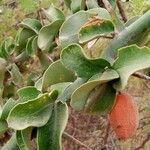A medium sized tree. It grows to 10-20 m tall. The tree branches about 1.8 m above the ground and has spreading branches. The trunk is 30 cm across. It has buttresses. The trunk is deeply folded. The bark is light grey and smooth. Branches which do not produce fruit have sharp thorns up to 4 cm long and then branches which produce fruit which do not have thorns. The spines are forked. The leaves on the two kinds of branches also vary. The leaves are compound with 2 leaflets on very short furry stalks. On the branches which do not produce fruit the leaves are longer. They can be 3.5-8 cm long and 6 cm wide. They are pointed. Leaves on fruiting branches have rounded ends. The flowers are small. They have a scent. They occur in small bunches. They have greenish yellow oval petals. The fruit are 5 cm long usually with 5 grooves. The outer shell is brownish-yellow. They contain a large bony stone surrounded by a thin layer of flesh. They are edible.
Leaves petiolate; leaflets of the flower-bearing shoots ± asymmetric, 2·3–6 × 2·25–5·7 cm., lanceolate-elliptic, ovate or broadly ovate to circular, apex rounded or obtuse, rarely shortly acuminate, base broadly cuneate or rounded, coriaceous, densely pubescent to subtomentose on the lower surface, pubescent or rarely glabrous on the upper one; petiole 1–2·8 cm. long, stout, pubescent or glabrous; petiolules 0·4–1 cm. long, ± densely pubescent; leaflets of the sterile shoots, 6·5–8 × 5–7 cm. = asymmetric, broadly ovate to subcircular, apex obtuse and usually shortly acuminate, base ± broadly cuneate, rounded or very rarely subcordate, coriaceous, ± densely pubescent on the lower surface and glabrous on the upper one or glabrous on both; petiole 2·3–3 cm. long, stout, pubescent or glabrous; petiolules 0·6–1·2 cm. long, ±: densely pubescent at first, later usually glabrescent.
Tree up to 20 m. high, with a fluted trunk up to 0·75 m. in diam.; branches of two kinds, some sterile and mostly spiny, others flower-bearing and unarmed or with only tiny spines; younger branches green and pubescent, older ones glabrescent, often lenticellate; spines of the sterile shoots (1) 3–6 cm. long, stout, usually ± regularly forked, rarely simple or with one of the branches shorter than the other.
Drupe (3) 4–6 (7·5) × (2) 2·5–3 (3·5) cm., cylindric-ellipsoid, rarely subclavate, longitudinally 5-grooved (more distinctly so in the upper half), with a deep basal depression and a smaller apical one left by the pedicel and the style respectively, with a rather thick spongy mesocarp, endocarp woody (3–6 mm.) thick, exocarp crustaceous.
Petals greenish or yellowish, (6·5) 7–8 (10) × 1·9–2·6 mm., oblong-lanceolate or lanceolate, ± densely villous on the upper surface, glabrous on the lower one, somewhat crumpled at the apex, scented.
Tree, up to 20 m high. Spines usually forked, rarely simple. Leaves 2-foliolate, pubescent. Petals densely hairy on adaxial surface. Flowers green or yellow.
Sepals (4) 4·5–5·6 × (2) 2·4–3 (3·3) mm., coriaceous, densely yellowish-or greenish-pubescent to subtomentose outside, whitish-sericeous inside, caducous.
Inflorescences of dense 3–7-flowered umbel-like cymes, pedunculate or often nearly sessile, ± densely yellowish-tomentose all over.
Ovary densely covered with long ± stiff white hairs, very rarely glabrescent.
Stamens with anthers 1·2–1·6 mm. long; filaments (2·5) 3–3·2 (3·8) mm. long.
Flowers 1·5–2 cm. in diam.


